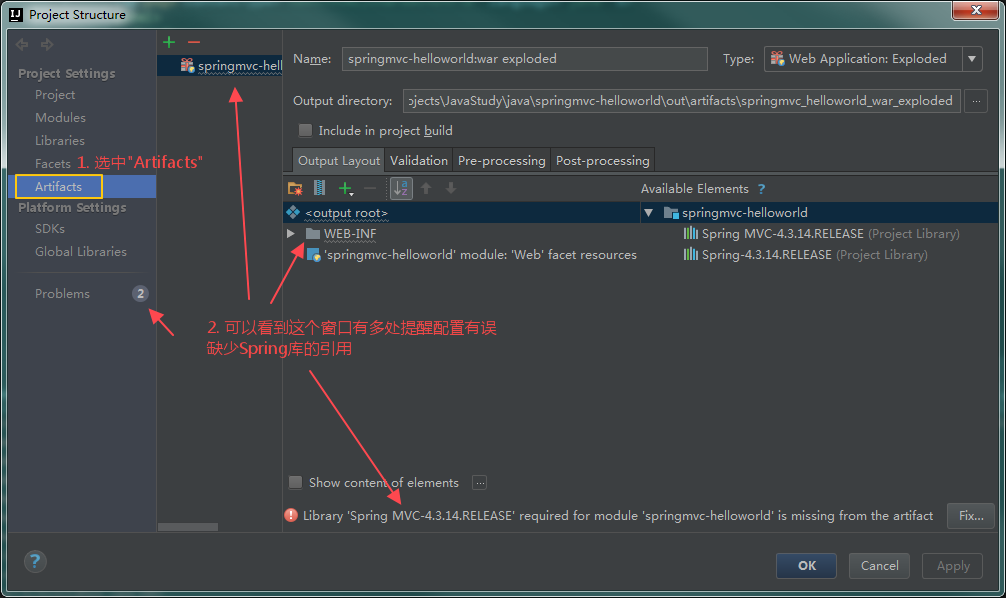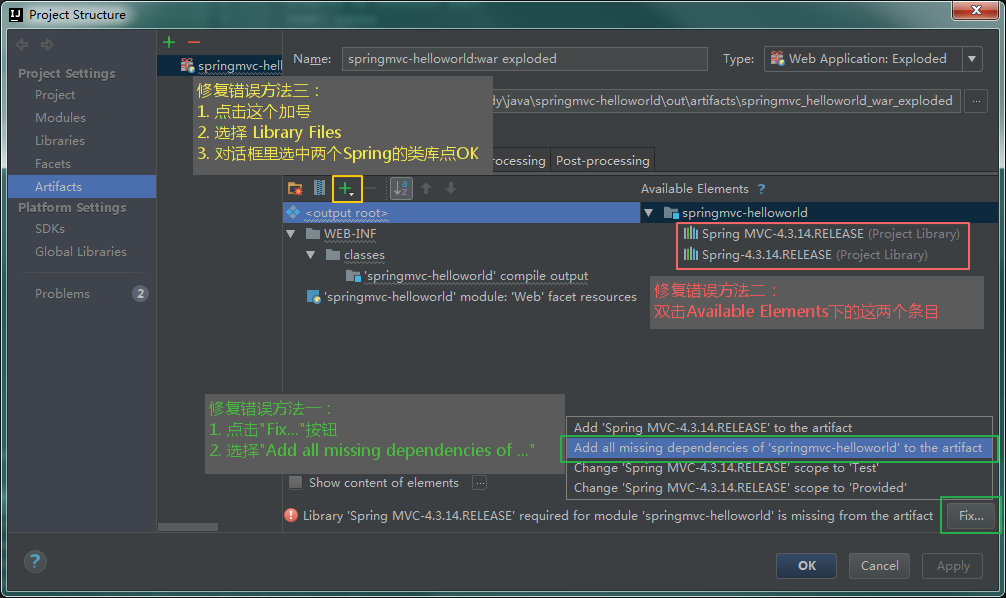https://www.cnblogs.com/wormday/p/8435617.html
创建Spring MVC项目
File -> new -> Project… -> Spring -> Spring MVC
配置
run -> Edit Configurations…



配置
File -> Project Structure…


运行
浏览器输入地址 http://localhost:8080/index.jsp
添加Controller
站点可以打开了,不过我们这个不是MVC,因为没有M、没有V也没有C
我们就从MVC中的C(Controller)开始,继续配置
在新建Controller之前,首先要建一个包,SpringMVC是没法运行在默认包下的,按照如下方式建包,
我建的包名称为:test
其实包名随意,但是必须要有。。。
再这个包下新建Java Class文件 MyController
1 2 3 4 5 6 7 8 9 10 11 12 13 14 15 16 17 18 19 20 21 22 23 24 25 26 27 28 29 30 31 32 33 34 35 36 37 38 39 | |
也可以只把注解写在方法上,比如@RequestMapping(“mvc/hello”)
这个Controller的Action 地址应该是:
http://localhost:8080/mvc/hello.form 其实这个时候访问结果是404,因为后边还有不少配置没有做…
修改 url-pattern(web.xml)
先打开web\WEB-INF\web.xml文件
有关于ServletMapping的设置,通过这个设置,可以配置那些类型的url用那些servlet来处理
1 2 3 4 5 6 7 8 9 | |
结合这一段xml,我们可以看到,IDEA默认帮我配置了一个名字叫做dispatcher的Servlet
这个Servlet使用org.springframework.web.servlet.DispatcherServlet这个类来处理
这个Servlet对应的Url是*.form
如果你跟我一样不喜欢每个MVC Url后边都带一个form,可以改成斜杠
1
| |
如果你现在重新启动程序,然后继续访问http://localhost:8080/mvc/hello
发现,依旧404,并且伴随每次访问,都在Server的Output窗口有一个错误日志
org.springframework.web.servlet.PageNotFound.noHandlerFound No mapping found for HTTP request with URI [/mvc/hello] in DispatcherServlet with name ‘dispatcher’
意思就是没有找到相应的Controller,不但要把Controller的代码写好,还要告诉Spring(在这里其实是dispatcher servlet)去哪里找这些Controller。。。
作为验证,你可以在Controller里边加一个断点,然后刷新页面,程序根本就没有执行到Controller里边
配置 component-scan(dispatcher-servlet.xml)
component-scan就是告诉Servlet去哪里找到相应的Controller
打开 dispatcher-servlet.xml
在已经存在的
1
| |
再加上view前后缀
1 2 3 4 5 6 7 8 9 10 11 12 13 14 15 16 17 18 19 20 21 22 23 24 | |
base-package指定的就是存放Controller的包
做完这一步之后,重新启动项目,再次访问 http://localhost:8080/mvc/hello
这次应该还是404错误,不过比刚才的404错误前进了一大步
毕竟这次Controller已经执行了,如果刚才的断点没有去掉,你可以验证一下看看
这一回是因为是“hello”这个View找不到(我们刚才确实只是告诉他这个位置,但是从来没有创建过这个文件)
添加视图文件(.jsp)
在 web/WEB-INF/jsp 下创建 hello.jsp
1 2 3 4 5 6 7 8 9 | |
通过 Model 向 View 传值
通过上面的操作,已经完成了MVC中的(V和C),M还没见影子,让我们继续修改
打开刚才定义的Controller 也就是 MyController.java文件
增加 ui.Model
打开copy来的项目时
要在 File -> Project Structure… -> Project Settings -> Project -> SDK -> new sdk -> JDK 主路经: /usr/lib/jvm/jdk-15.0.1
err1: Unsupported class file major version 57
File -> Settings…
Build, Execution, Deployment -> Compiler -> Java Compiler 修改 project bytecode version
err2: java.lang.ClassNotFoundException: org.springframework.web.context.ContextLoaderListener
在IDEA中点击File > Project Structure > Artifacts > 在右侧Output Layout右击项目名,选择Put into Output Root。
执行后,在WEB-INF在增加了lib目录,里面是项目引用的jar包,点击OK。


